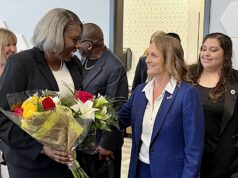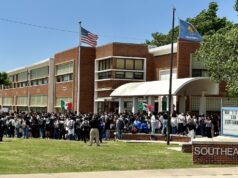During the first of Oklahoma City Public Schools’ Pathway to Greatness community meetings, Superintendent Sean McDaniel told 150 “skeptical parents” that “we have got to figure out a better way for our kids.”
McDaniel said that no decisions have been made, but tough choices are coming in regard to closing and re-purposing schools. He explained that this would be a “data-informed” process that views evidence through the perspectives of stakeholders as well as professional educators. There will be trade-offs, but he said he is seeking input to maximize “trade-ups” for our kids. He said his prime focus is on equity.
McDaniel spoke until 6:38 p.m. Nov. 5 at Star Spencer High School and promised to stay as long as the people had something to say. The meeting lasted almost three hours.
Attendees vented frustrations, McDaniel listened
Although the angrier questions and comments got the most applause, the level of discord was much lower than during previous meetings in recent years. The reason, I believe, is that the crowd saw this meeting as fundamentally different than the dog-and-pony shows that have become the norm since the MAPS for Kids community meetings.
After a parent told the superintendent, “Our children have been kicked under the bus,” McDaniel replied that the process is designed to “address what you just said.” When another angry statement prompted applause, he said, “Everything that is being said is what we’re here to hear.”
And when a parent who had already made forceful statements came back to make additional comments, McDaniel celebrated her intense desire to speak out. He good-naturedly joked that she should stop holding her feelings in.
Similarly, when a patron offered to open his house so the superintendent and/or board members could stay in Spencer for a week and take a deep dive into the schools, McDaniel grinned about not quite being ready to take up that offer, but he appreciated it.
The superintendent also heard complaints about charters that “harvest the top of the crop.” Another patron/educator protested the costs of programs for coaching teachers on classroom instruction. Concerns were expressed about discipline problems driving out teachers. McDaniel observed that the fatigue at this district is worse than anywhere else he had worked.
One of the most interesting exchanges was prompted by a coach who said that some students who had participated in a Pathway to Greatness discussion complained that the district seemed interested only in south-side issues. McDaniel replied that he was the one who was talking with the 18 students. “If I was misunderstood,” he said, “I own it.” The audience seemed convinced by his sincerity.
Not surprisingly, the audience also expressed contradictory feelings. The best example may have been a parent who spoke at length about how much he loves Spencer. His daughter feels the same and recently expressed her commitment to return to Spencer. The family was clearly pained by their decision to send the daughter to Mid-Del schools as opposed to their own neighborhood schools.
Ultimately, the patrons who expressed their concerns seemed impressed with McDaniel’s response to their complaints.
“I get it,” he said.
OKCPS release data
Two studies of safety and demographics were also posted on the district’s web site. It’s great that the issue of safety is being taken seriously. As a patron said during the Nov. 5 meeting, the district should take into account Star Spencer’s positive school culture. He said that Star is the only high school that didn’t have a fight during the first nine weeks.
Sure enough, Star Spencer’s suspension rate is about one-third of my old school, Centennial. And that is why the data-informed, as opposed to data-driven, nature of the process is so important. The OKCPS is now respecting the feelings of patrons about their schools and their cultures.
Some of the newly published data is exceptionally powerful, but some OKCPS data remains incomplete. For example, the Spencer district has four elementary schools. Between 80 and 85 students live within a mile of Spencer and Green Pastures elementary schools, however, 275 and 410 students, respectively, live within a mile of Telestar and Willow Brook. The problem is that the OKCPS didn’t report how many students attend their neighborhood schools. Other OKCPS data shows that Willow Brook has 511 students, while the other three range from 238 to 291.
Analyzing the data surrounding Spencer
Spencer illustrates just one example of why numbers alone can’t produce better policy making. It would be easy to make the case that the distance between Spencer and the rest of the OKCPS helps explain why its schools have a unique value: Being more isolated, relatively fewer of their students may be leaving their home schools for magnets and charters.
On the other hand, the Spencer schools’ isolation made it tough for them to recruit new students. The distances between their rural schools and the urban OKCPS could be used as an argument as to why the district must close more buildings than it would like.
It could be equally valid to argue that those distances mean that closures of too many Spencer schools would impose excessive harm by requiring students to spend too much travel time on buses. That could prompt even more flight of families from Spencer to other districts, making the OKCPS’s challenges more daunting.
Pathway to Greatness could be, well, great
The same type of complex decisions must be made in the near east side and the northwest parts of the OKCPS. If the Pathway to Greatness community meetings build trusting relationships with patron and community partners, we could reclaim the promise of MAPS for Kids, which saved the district from being dismantled but failed to permanently improve student performance after No Child Left Behind and corporate school reform undermined teaching and learning.
I hope the entire OKCPS leadership and the communities they serve will use data-informed discussions for meaningful planning. This new process could now be the district’s last chance.




















